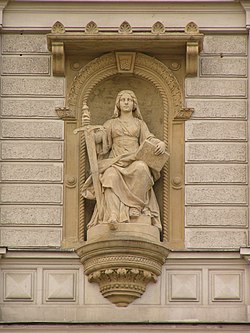
Lady Justice (Latin : Iustitia) is an allegorical personification of the moral force in judicial systems. [1] [2] Her attributes are scales, a sword and sometimes a blindfold. She often appears as a pair with Prudentia.
Contents
- The goddess Justitia
- Depiction
- Scales
- Blindfold
- Sword
- No blindfold and no sword
- Toga
- In computer systems
- In art
- Sculpture
- Painting
- Heraldry
- See also
- Goddesses of Justice and related concepts
- Astronomy
- Notable programs
- In fiction
- In popular culture
- References
- External links
Lady Justice originates from the personification of Justice in ancient Roman art known as Iustitia or Justitia, [3] who is equivalent to the Greek goddess Themis.[ citation needed ]





























